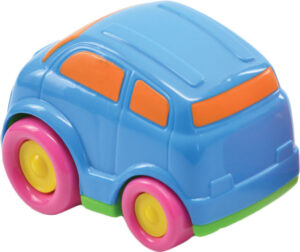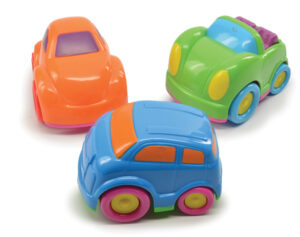Concentration
Toddlers watch and listen to a caregiver describe moving and stopping a toy car.



[Invite several toddlers to join you on the floor for a car activity. Drive the car back and forth in front of you on the floor.]
 I am pretending that I am driving our toy car. Our car is moving back and forth. Watch how I am driving our car.
I am pretending that I am driving our toy car. Our car is moving back and forth. Watch how I am driving our car.
[Pause for and recognize the toddlers’ responses. Example: “Tomeka said ‘zoom!’ Tomeka is telling us that a car can drive fast. I can help our car drive fast!”]
Where should I drive our car? Where should our car go?
[Pause for suggestions. If none are offered, suggest a familiar place, such as a grocery store. Drive the car in some straight lines with occasional turns.]
Our car is running out of gas! I need to stop driving our car so it can get some gas. Our car stops moving when I stop driving it.
[Hold the car still for the toddlers to see. Pretend to put gas in the car.]
I stopped driving our car. The car is not moving. Our car is getting gas!
[Begin moving the car again.]
Our car finished getting gas. I am driving our car again. Our car is moving again. Moving, moving, moving.
I am getting close to the (destination). I will stop driving the car so I can go into the (destination). Our car is not moving. It is waiting for me to spend time at (destination).
[Hold the car still for the toddlers to see.]
Should I drive the car someplace else when I am done at (destination)?
[If one or more toddlers respond positively, ask where to go with the car and repeat the process of moving and stopping the car. Emphasize the words move and stop moving.]
You watched me drive our toy car. Our car moved when I pretended to drive it. Our car stopped moving when I stopped driving it. We had fun watching the car move and then stop moving.
Concentration
Toddlers move and stop toy cars in response to verbal requests.



 Invite several toddlers to join you on the floor to play with toy cars. Give each toddler a toy car to hold and provide time for toddlers to explore their car. Explain that each of us can make our car move by driving it. Then we will stop our car from moving. Demonstrate how to move a car. Create a pretend destination for your car. Example: “I am driving my car to a store to buy some milk. My car is moving.” Then demonstrate how to stop your car from moving. Emphasize the word stop. Offer a pretend reason for stopping the car. Example: “I am going to stop driving my car. I want to put some gas in my car. My car does not move when I stop driving it.”
Invite several toddlers to join you on the floor to play with toy cars. Give each toddler a toy car to hold and provide time for toddlers to explore their car. Explain that each of us can make our car move by driving it. Then we will stop our car from moving. Demonstrate how to move a car. Create a pretend destination for your car. Example: “I am driving my car to a store to buy some milk. My car is moving.” Then demonstrate how to stop your car from moving. Emphasize the word stop. Offer a pretend reason for stopping the car. Example: “I am going to stop driving my car. I want to put some gas in my car. My car does not move when I stop driving it.”
Invite the toddlers to drive their cars to a pretend place. Describe the toddlers’ actions with their cars. Example: “Jayla’s car is moving. Layne’s car is moving. All of us are driving our cars somewhere!”
After about a minute, announce that the cars need to stop to get gas. Remind the toddlers that cars do not move when we stop driving them. Example: “Layne stopped driving his car. His car is not moving. His car is getting gas.”
Offer one more round of toddlers driving their cars and then stopping their cars. Explain that it is time for our cars to rest. Our cars do not move when they are resting. Acknowledge all forms of participation. Briefly describe what happened, emphasizing how we made our cars move and then stop moving. Example: “We had fun pretending to drive toy cars. We helped our cars move. Then we stopped driving. Our cars stopped moving when we stopped driving. Now our cars are resting.”
Option 1 supports toddlers’ concentration skills through watching and listening, whereas Option 2 supports concentration skills through actions in response to verbal requests. Toddlers will likely differ in their level of attention to your actions with a toy car (Option 1) and in their ease of stopping the movement of their own car (Option 2). Flexibly accept a range of responses to the Option 2 activity while offering gentle reminders and encouragement to pay attention to your requests. The pretend element of the activity is intended to support interest in the car’s movements. Some toddlers will be more interested than others in having, or contributing to, a purpose for the car’s actions.
Extra support
Enrichment
Materials Needed: variety of blocks in the block area, variety of toy cars and trucks
Invite several toddlers to play with the toy cars and trucks in the block area. Toddlers may want to build structures for the cars and trucks to drive on. Encourage toddlers to drive and then stop their vehicles. Enhance the challenge of the roadways by adding stopping places, such as at an intersection of two streets.
Materials Needed: variety of blocks in the block area, variety of age-appropriate toy cars and trucks
Invite toddlers and older children to play independently with toy vehicles in the block area after participating in Option 2. Children may want to build structures for their cars to drive on or park inside. Encourage children to drive and then stop their vehicles while they play.